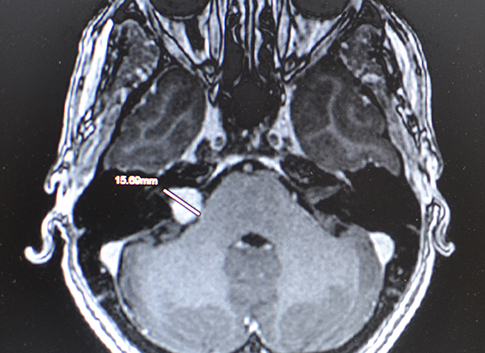Acoustic Neuroma and Skull Base Disorders

In the modern medical era, acoustic neuromas are typically found early in their course via MRI scan. The majority are small to intermediate in size (5-15 millimeters in diameter). Symptoms leading to diagnosis typically include asymmetric (one-side) hearing loss, dizziness, imbalance, and/or ringing in one ear. Rarely, patients may also describe facial twitching or weakness, numbness of the face, headaches, and fullness/pain in one ear among other symptoms. Once detected, patients will typically be referred to one or more members of a specialized team that are highly trained to follow and treat this condition when necessary. This team typically may include a Neurotologic surgeon (Dr. Stevens and Dr. Whitaker), a neurosurgeon, audiologists, and in some cases, a radiation oncologist.
When detected at a small size and/or early in the disease course, patients typically have multiple options when it comes to management of this condition. This could include watchful observation of the tumor with MRI scans repeated periodically, specialized radiation therapy, microsurgical resection, or a combination of these approaches. The selection of a treatment course is highly specific to each patient’s individual case. Decision making may be based upon one’s age, overall health, tumor size and location, tumor growth, presenting symptoms, occupation, and personal preferences of the patient. When a large tumor is detected, the recommendation is typically surgical as these tumors may prove threatening to a patient’s health and are less amenable to other treatment options. There is currently no medical or chemotherapeutic treatment for acoustic neuromas.
In the current era, many acoustic neuromas are observed as they are typically detected at a small size. However, the most important variable in selecting a treatment option in the context of a small tumor has now become the state of the patient’s hearing. Dr. Stevens and Dr. Whitaker are highly trained to perform specialized ‘hearing preservation microsurgery’ for acoustic neuromas and other tumors of the skull base. This new treatment paradigm typically allows for a complete or near-complete resection of the tumor with preservation of most or all of a patient’s hearing in that ear. Success rates for hearing preservation range between 50-80% depending on various patient-specific factors. If you are a potential candidate for this cutting-edge procedure, a detailed discussion with your surgical team is advised and will be facilitated by the AEI surgeons. Dr. Stevens and Dr. Whitaker also are certified and specialized to treat acoustic neuromas with radiation techniques. These include Gamma Knife and Cyberknife facilities located in the greater Phoenix area. While radiation does not cure these tumors, it does stop them from growing. Radiation may be an excellent treatment option in patients of advanced age and/or poor overall health. Radiation is less useful in young patients and in patients with large tumors. It also cannot be used to preserve hearing in patients where that is a concern. Discussions regarding radiation therapy will typically be team based and can be initiated with our surgeons at AEI.
Patients presenting with familial-acoustic neuromas or Neurofibromatosis Type 2 often constitute special cases requiring a dedicated treatment team and intricate planning. Acoustic neuromas in these cases may involve both nerves of hearing and balance, may grow more rapidly/aggressively, may lead to permanent deafness, and may be associated with other tumors of the brain, spinal cord, and nervous system. For patients in this situation, Dr. Stevens and Dr. Whitaker will establish your care within a broader, multi-disciplinary team based at the world renowned Barrow Neurologic Institute in Phoenix. Dr. Stevens and the AEI team of audiologists are also certified to implant and program auditory brainstem implants, devices frequently used in patients with NF-2 to restore hearing sensation.
In addition to acoustic neuromas, Dr. Stevens and Dr. Whitaker also treat numerous other tumors and conditions of the lateral skull base. These include, but are not limited to: meningiomas, epidermoid tumors, hemangiomas, glomus tumors (paragangliomas), schwannomas of other cranial nerves, cancerous tumors, inflammatory diseases and infectious disorders. No matter your diagnosis, our surgeons, audiologists, and support team at AEI are proud to offer excellent, customized, and highly patient-centric care. Our team is also proudly dedicated to a wide range of academic endeavors and are actively involved at the local and national levels with clinical research, publishing, lecturing, and public speaking. Through this work, we hope to provide the people of Arizona and the region with world-class care of lateral skull base disorders and tumors.
